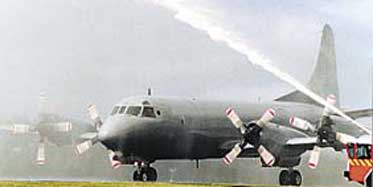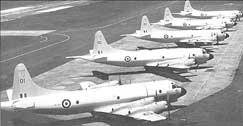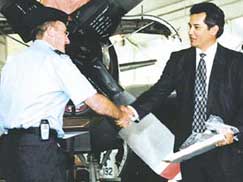A magnificent milestone for 5 Squadron
On Friday, 22 November 2002, No 5 Squadron RNZAF held a celebration at RNZAF Base Whenuapai to mark the Squadron's 100,000th hour being flown by its Lockheed P3K Orion fleet.

To the moon and back x 100
A magnificent milestone for 5 Squadron
On Friday, 22 November 2002, No 5 Squadron RNZAF held a celebration at RNZAF Base Whenuapai to mark the Squadron's 100,000th hour being flown by its Lockheed P3K Orion fleet.

plane being showered by fire engine
A CELEBRATORY SHOWER: The Whenuapai Fire Section extends a warm but wet welcome to 01 on its return from the handling display.
The event was an opportunity for past and present members of No 5 Squadron, together with Defence Ministry, NZDF and aviation industry representatives to celebrate the Squadron's contribution to New Zealand and its defence partners' maritime surveillance and security.
Between 4 and 6 November 2002, three sorties were flown from Whenuapai in the hope of locating a beacon which had been activated about 500 nautical miles off New Zealand's East Cape. The 100,000th hour mark came up during that search and rescue mission on 5 November, rather fitting considering the long and proud history of SAR operations for which 5 Squadron is renowned. The beacon was found, but no vessel was located in the area.

historic photograph of planes
THE ORIGINALS: No. 5 Squadron's first five P3Bs lined up on the tarmac at Whenuapai.
The RNZAF acquired five Lockheed P3Bs in 1966 making New Zealand the first country outside the United States to own and operate Orions. There are now 15 other nations flying some 750 of this tried and true maritime surveillance sub-hunter. A sixth aircraft was acquired from the RAAF in 1985.
Throughout their service, the RNZAF's P3s have flown 50 million kilometres, the equivalent of 1300 times around the globe, 100 times to the moon and back or spending 11½ years continually in the air while consuming 250 million litres of fuel in the process!
Former 5 Squadron CO, Air Commodore Ivor Mackay RNZAF (Rtd), also had his calculator out ending up with the equation of having one P3 in the air for 7.6 hours every day for the whole 36 years the aircraft have been in service in New Zealand.
The celebration kicked off with a handling display over Whenuapai, showing that, even at 36 years of age, the Orion, older than most of its crews, is still one of the most athletic aircraft in its class, and that there is still plenty of life left in the airframes.
After medal presentations to three 5 Squadron staff, both the Chief of Air Staff, Air Vice Marshal John Hamilton and the Chief of Defence Force, Air Marshal Bruce Ferguson addressed squadron members, both past and present, congratulating the squadron on its achievements and in particular the maintenance personnel for the aircrafts' pristine condition after all these years.

presentation
CONGRATULATIONS: Lockheed Martin's representative in New Zealand (right) hands a plaque commemorating the 100,000 hour event to 5 Squadron's Commanding Officer Wing Commander Carl Nixon.
Lockheed Martin was next onto the dais, relaying the company's congratulations to the squadron and presenting Wing Commander Carl Nixon, the Squadron's Commanding Officer, a plaque commemorating the event.
Wing Commander Nixon said, it was a great achievement to have reached the milestone. "It is a credit to all those who work to keep the aircraft in the air and operating to such a high standard," he said.

cutting the cake
100,000 HOURS!: Former Maritime Wing Commander Air Commodore Mal Gunton RNZAF (Rtd), cuts the cake.
With the formal part of the evening complete, glasses were filled and a toast made to the squadron before the celebratory cake was cut by Air Commodore Mal Gunton RNZAF (Rtd), a former Maritime Wing Commander. The barbecues were then lit, dinner served and squadron personnel, guests, families and friends were able to mingle, reminiscing over adventures from previous years and speculating over those still to come.